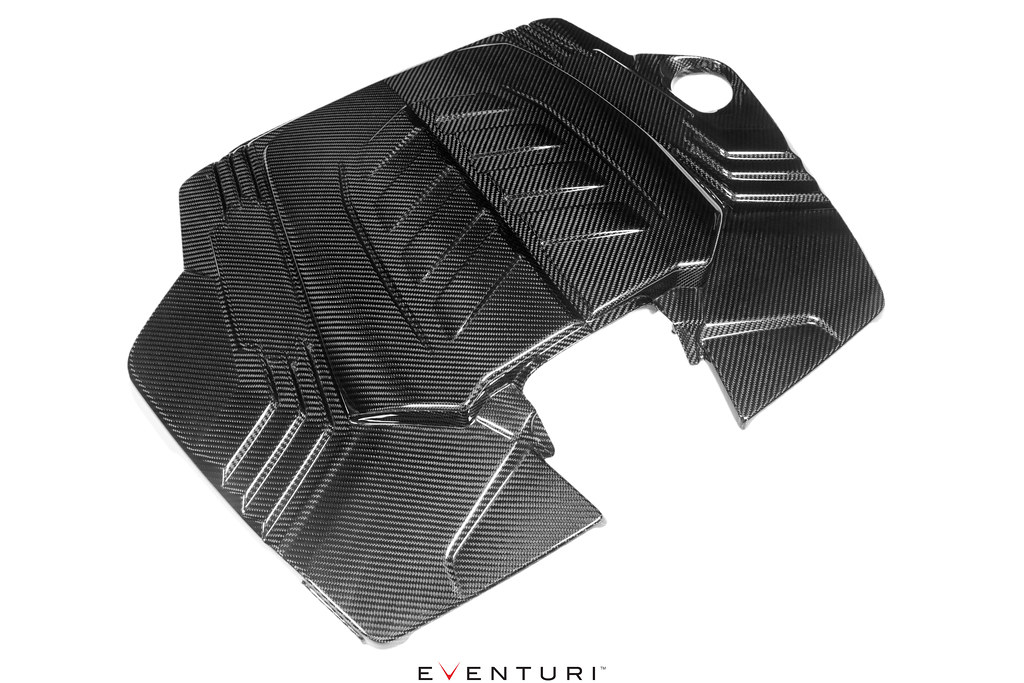Eventuri intake Lamborghini Urus | Audi RSQ8 / SQ8 / SQ7 | Porsche Cayenne Turbo
Do you have a question about this product?
Our employee is happy to help you find the right product
Our employee is happy to help you find the right product
The Eventuri 4.0TFSI V8 intake system consists of a number of components designed for a specific purpose and manufactured to the highest standards. We use 100% pre-preg carbon without fiberglass, which means we can achieve a smooth inner surface to maintain smoother airflow. Here are the details for each part and the design ethos behind them:
Each intake system consists of:

ENLARGED AIRBOX COVER
The first limitation we had to overcome to dramatically increase the overall volume of the intake was the airbox cover. The storage cover leaves a shallow opening for the current collector and also limits the filter media used. By creating a raised area in the center of the lid we can create more space for a larger current collector and also for larger filters. The lid is made of prepreg carbon fiber and uses the same mounting points as the standard lid. 
CARBON FLOW COLLECTOR & FILTERS
Directing the airflow from the filters to the turbo inlets is the flow collector. The standard version is limited in size due to eth stock kid, but after removing that limitation we were able to dramatically increase the volume of our version. In addition, this also gave us the freedom to replace the stock filter with higher-flow cone filters that also have a larger total surface area. 
TURBO INTAKES
The biggest limitation in the stock system is the turbo intakes. The stock inlets are not only small in size, but also have 2 flexible sections. The flexible section directly in front of the turbo creates turbulence when the engine moves during acceleration. To combat this, the stock inlets also have flow guides at the exit of the inlets, but these also create a restriction. We removed the first flexible section, which also meant we could increase the internal volume. Increasing the intake sizes allows the turbos to draw air with less restriction, allowing for a faster spool. In the following photos you can see the differences in sizes. 
We could have finished the designs here, but we wanted to push the boundaries further and introduce a new dimpled pattern on the interior surfaces. In theory, small dimples can increase flow by reducing frictional pressure losses through a pipe. We explained this in detail in our video for the G80 M3 intake found HERE . 
A lot of R&D went into simulating different sizes and shapes until we found an optimized version that showed a higher flow through the inlets compared to a smooth surface. Applying such a complicated technique was only possible thanks to the advanced manufacturing technique we used to create the inlets, where traditional methods would not have achieved the required accuracy. The dimples create an "air cushion" effect over the surface of the intake, allowing the main body of air to "slide" through the body into the turbo with less friction. This results in a more uniform velocity profile in a dimpled tube, with the net effect being a higher velocity for the same boundary conditions. Here are the CFD simulations showing the recirculations in the dimples and the higher velocity in the dimple tube. You can read further from these scientific articles:
Flow studies on increasing intake manifold efficiency .
Hydrodynamics of laminar flow through indented pipes . 
The complete system comes together to provide an intake that enhances the stock airbox in performance, aesthetics and sound.........